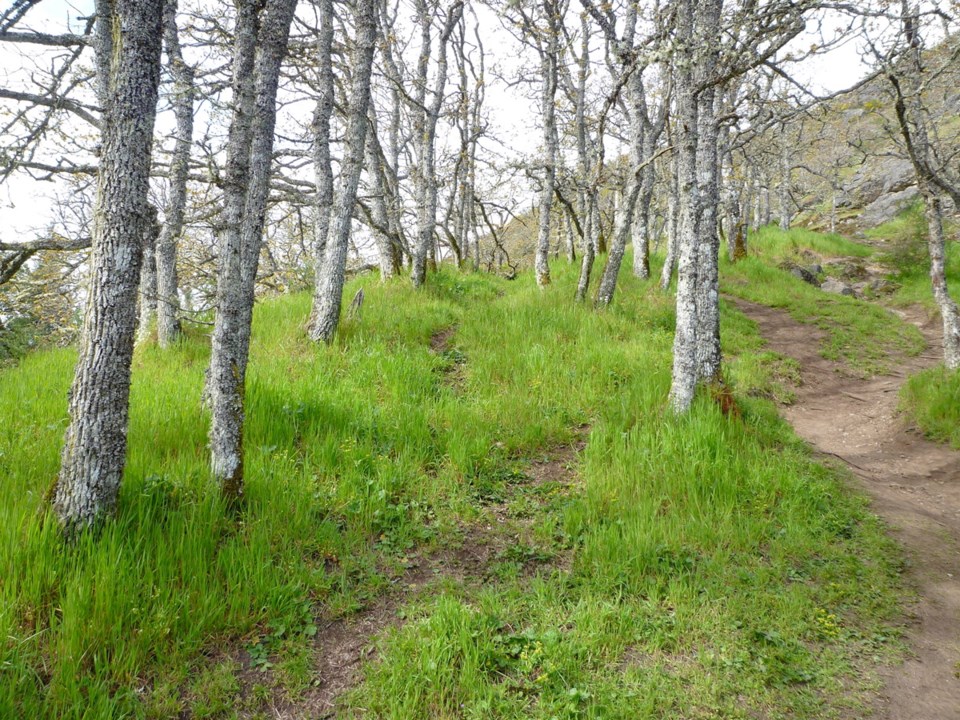Saanich should be bound by its own bylaw to protect environmentally sensitive areas, given that district parks make up about half of such identified areas, a consultant’s report says.
According to the $50,000 independent review by Diamond Head Consulting of Vancouver, Saanich should include district-owned lands that are now exempt from the 2012 Environmental Development Permit Area, in order to show it is “leading by example.”
The 77-page draft report goes to council on July 24.
If it were bound by the bylaw, the district would have to meet the same requirements to protect sensitive areas during construction projects, maintenance or operation of municipal works and services as do an estimated 2,200 homeowners in the permit area. The report suggests the EDPA guidelines should also apply to Capital Regional District projects within Saanich.
“Through the engagement process, we heard that stake-holders generally seem to agree that the District of Saanich could do more to lead by example when it comes to working in and around environmentally significant areas; and to encourage environmental stewardship,” the report says.
“Many felt that requiring restoration on private land was difficult for many residents to accept when nearby parkland was not receiving similar standards of care.”
Diamond Head consulted with several environmental groups, eight residents associations, groups that defend and denounce the existing bylaw, nine other jurisdictions with similar bylaws and the B.C. Assessment Authority.
The report said many respondents called for better management and preservation of environmentally sensitive areas on public land, and more restoration of degraded public areas.
They also said Saanich should take the lead on removal of invasive species and planting of native species in park land.
There are 1,520 acres of Saanich-owned land within the EDPA.
The bylaw is meant to protect sensitive and threatened environmental areas containing endangered species and habitats, including Garry oak ecosystems, by restricting the kinds of changes that can be made to properties. It applies to native trees, plus shrubs, flowers, rocks, soils and other habitat features necessary to support ecological diversity, the Saanich website says.
Many respondents made comments indicating they do not trust that public land is held to the same standards as private land, the report said.
The Saanich bylaw has faced “significant public opposition despite the fact that similar EDPAs are implemented in many other B.C. municipalities without incident.”
About half of the nine local governments that Diamond Head surveyed already follow their own permit regulations when doing municipal work, the report said, citing as an example Kelowna, where all departments are required to get a development permit unless the type of work is specifically exempted.
In Campbell River, the city is not required to get a development permit, but departments are expected to follow the same environmental standards as those applying for a permit, the report says.
Including Saanich property in the EDPA application process might add time and cost, and even require hiring more staff to handle the extra work, but might lead to streamlining of the approval process, the report said.
The private homes covered by the 2012 Environmental Development Permit Area bylaw make up about five per cent of the district’s total sensitive area, while 52 per cent is found on municipal land, mostly parks.
On June 12, council amended the EDPA bylaw to temporarily exempt properties with single-family residential zoning except in the case of subdivision application.
In May, council held a five-hour public hearing and then voted to exempt 29 properties from the EDPA area.
Saanich planning director Sharon Hvozdanski said in a report to council that public input on the report is required, likely at a special council meeting at a venue large enough to accommodate anyone who wants to address it.
Among short-term recommendations from Diamond Head:
• Remove the EDPA atlas map (often criticized as out of date) and replace it with text-based descriptions to flag properties that might contain sensitive areas.
• Define classes for habitat condition that will guide professionals in required restoration efforts.
• Provide a standard template for qualified environmental professionals making reports for applications.
• Update EDPA objectives to more directly link with the Saanich Official Community Plan,
• Amend guidelines to include conditions for encroachments on environmentally significant areas in consideration for smaller lots,
• Develop a standard that guides restoration required based on the condition of the environmentally sensitive area and the size of the proposed development.
• Allow flexibility in setbacks by permitting some minor encroachment when unavoidable provided there is compensation elsewhere on the property.



